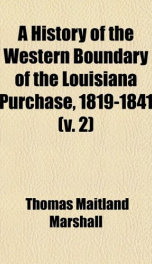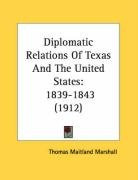a history of the western boundary of the louisiana purchase 1819 1841

Purchase of this book includes free trial access to www.million-books.com where you can read more than a million books for free. This is an OCR edition with typos. Excerpt from book: CHAPTER III THE TREATY OF 1819 While Spain was in the throes of the Peninsular War. her grasp upon her colonial possessions became weaker and weaker. In South America Bolivar, San Martin and others revolted, and in Mexico Hidalgo started a war of independence. By 1812 Texas had become a battle-ground for warring factions. The Mexican refugee, Gutierrez, and Magee, who had formerly been a lieutenant in the United States army, raised the standard of revolt at the head of several hundred men, many of whom were enlisted in the United States. After considerable fighting around La Bahia, the royalists were defeated at Rosillo, Governor Salcedo was captured, and in 1813 San Antonio capitulated. The governor and thirteen others were murdered. Magee had died at La Bahia and Major Kemper had succeeded him. The acts of atrocity at San Antonio caused the Americans to abandon the revolutionists. Gutierrez was soon after deposed and Toledo became the moving spirit. In August Toledo's forces were almost annihilated and Texas was again in royalist hands.1 In 1815 Captain Perry, a former follower of Magee, published a proclamation in New Orleans that a thousand men were ready to invade Texas. Madison issued a proclamation prohibiting such enterprises, but Perry eluded the authorities and crossed the Sabine with a small party, making their way to Galveston Island, where in 1816 they joined forces with the 1 Bancroft North Mexican States and Texas, II, 17-31. For the first period of the revolt see McCaleb, in Texas State Historical Association. The Quarterly, IV, 218-229. Arredondo's official report of the battle of Medina was obtained by Herbert E. Bolton from the archives of Mexico and is translated by Mrs. Hatcher in Texas State Historical Association, The Quarterly, XI, 220-232. M...
Info about the book
Author:
Series:
Unknown
ISBN:
1104594609
Rating:
3.5/5 (3)Your rating:
0/5
Languge:
English
Users who have this book
Users who want this book
What readers are saying
What do you think? Write your own comment on this book!
write a commentif you like a history of the western boundary of the louisiana purchase 1819 1841 try:
Do you want to exchange books? It’s EASY!
Get registered and find other users who want to give their favourite books to good hands!



